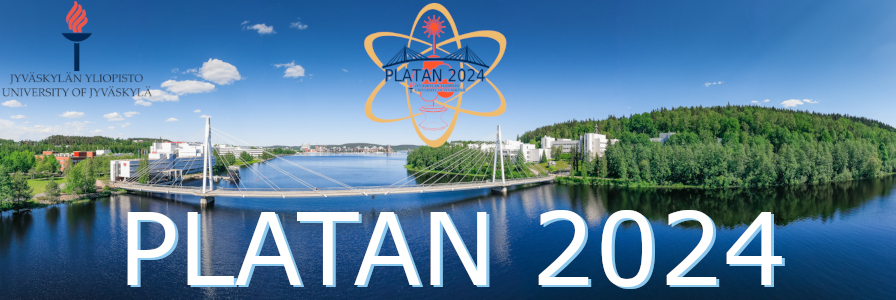CLaSsy is an experimental setup designed for laser spectroscopy on radioactive isotopes at the RAON ISOL facility in the Institute for Rare Isotope Science (IRIS), Korea. Laser spectroscopic technique provides the model-independent determinations of nuclear ground state properties, such as the mean-square charge radii and the electromagnetic moments. We have successfully installed the CLaSsy...
Resonant laser ionization is an efficient and highly selective method for producing radioisotopes. In the laser ion source of ISOLDE – RILIS (Resonance Ionization Laser Ion Source), the laser interaction region is (standardly) inside a metal tube which is heated to temperatures of >2000 degrees Celsius. This heating induces surface ionization from the walls of this so-called “hot cavity”,...
Gadolinium (Gd) is a rare earth metal belonging to the lanthanide series. Taking advantage of its large neutron absorption cross section and high $\gamma$-ray energy ($\sim$8 MeV in total) of (n,$\gamma$) reaction, Gd sulfate is dissolved in the Super-Kamiokande (SK) 50 kton water Cherenkov detector, which is being carried out as the SK-Gd project, to increase the detection sensitivity of...
Studies of atomic spectra through resonant laser excitation and ionization provide information on nuclear structure. Precise measurements of the hyperfine structure (HFS) give an experimental insight on the nucleus' deformation through the electric quadrupole moments and the single-particle structure through the magnetic dipole moments. However, this method is limited by low production yields...
To efficiently laser-ionize many different elements, the spectral range of the Ti:Sa lasers at ISOLDE RILIS is extended with nonlinear processes of second-, third- and fourth harmonic generation (SHG, THG and FHG).
We present a technique to intracavity generate ns pulses in the tripled Ti:Sa range (~ 230nm – 310nm) with a Gaussian beam shape and a size comparable to that of the fundamental...
Cavity ringdown spectroscopy (CRDS) is one of the most sensitive laser absorption spectroscopic techniques employing a highly reflective resonator. We have proposed to apply CRDS to the observation of rovibrational transitions of strontium oxide and its isotopologue, particularly toward the detection/measurement of radiative molecules such as 90SrO. Experimental details as well as the observed...
Within the recent FAIR phase-0 program, the Penning-trap mass spectrometer SHIPTRAP at GSI in Darmstadt, Germany, was used to extend direct high-precision mass spectrometry to superheavy nuclides (Z≥ 104) in the vicinity of the N=152 shell closure [1].
In spite of challenging experimental conditions as long measurement times due to low production rates down to few atoms per hour, the...
The fundamental properties of unstable nuclei are highly related to the nuclear structure and effective nucleon-nucleon interaction, which can be used to study various exotic structures of the unstable nuclei [1]. Laser spectroscopy technique is one of the powerful tools to study the nuclear properties (i.e. spins, moments and radii) by probing the hyperfine structure (HFS) and isotope shift...
In the decommissioning of the Fukushima Daiichi Nuclear Power Plant, a wide variety of samples containing fission products, nuclear fuel materials, actinide nuclides, and other materials are required to be analyzed. Resonance ionization mass spectrometry is suitable for the isotope analysis of such complex samples because it does not suffer from isobaric interference. For efficient resonance...
Laser spectroscopy experiments are an important tool for nuclear structure studies, providing nuclear-model independent observables that serve as anchor points for theoretical models. For the superheavy elements (Z ≥ 104), where stability is enhanced by shell effects, laser spectroscopy allows for detailed investigations of such nuclear observables as charge radii, nuclear moments and spin[1]....
The investigation of nuclear ground-state properties of short-lived radioactive isotopes through laser spectroscopy is an important probe of state-of-the-art nuclear-structure theories. This field has mainly been driven by Collinear Laser Spectroscopy (CLS) and Resonant Ionization Spectroscopy (RIS) in the last decades. In both techniques, the laser spectroscopy is performed in-flight which...
Laser Doppler cooling, a technique well-established since 1975, exploits laser light to cool atoms. When applied to trapped ions, this method leads to the formation of unique structures known as Coulomb crystals. These organized and cooled ion clouds present promising prospects in spectroscopy, particularly for species inaccessible to laser Doppler cooling via sympathetic cooling. The...
The inauguration of the buildings for the DESIR facility marked an essential step in developing experiments with low-energy radioactive beams in France. The LP2IB laboratory has been a primary driving force by devising several complex devices that will be the backbone of the facility. In this presentation, I will show the development work done for one of these devices, i.e. the double Penning...
Nuclear charge radii of silver isotopes have been extensively investigated using laser spectroscopy [1,2,3]. However, the dependence of this method on large-scale atomic calculations for mass and field shift determination introduces significant systematic uncertainties that dominate the uncertainty of the extracted radii. Deviations with nuclear density functional theory [1,3] further...
Studies of the atomic spectrum through resonant laser excitation provide access to nuclear structures. Precise measurements of the interactions of the nuclear ground state with the electronic shell permit the extraction of nuclear properties which are closely related to the nucleus’ configuration and shape. With atomic transitions in the range of a few eV, these are accessible with...

